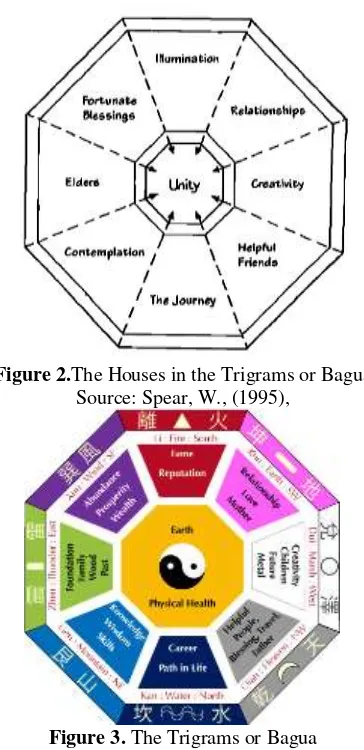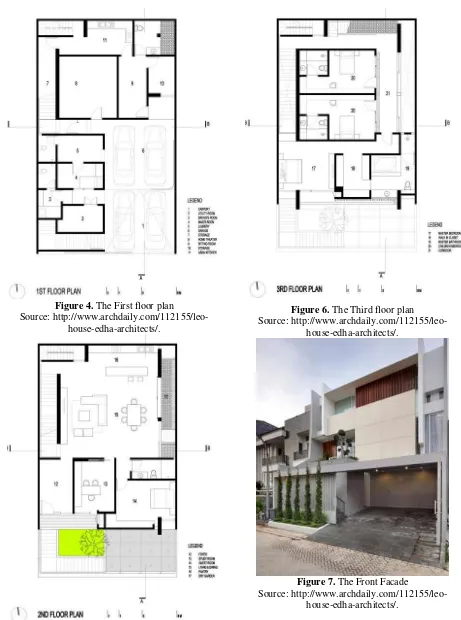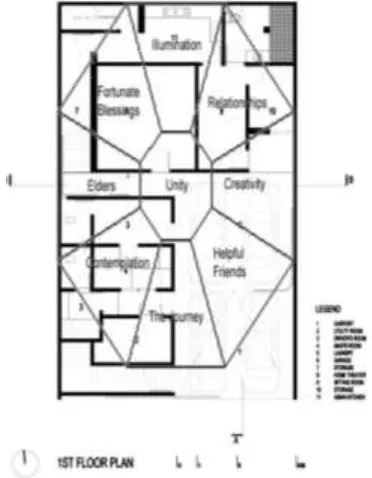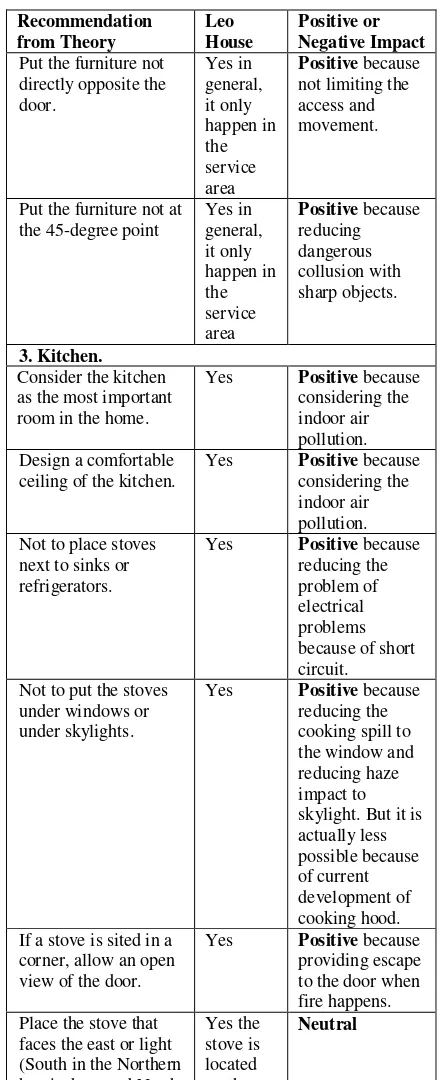THE RATIONALE AND THE IMPACT OF FENG SHUI APPLICATION IN MODERN 1
HOUSE DESIGN 2
3
Linda Octavia, 1, Gunawan Tanuwidjaja 1, 4
2 Duta Wacana Christian University, Architecture Program Study, Yogyakarta 5
1 Petra Christian University, Architecture Program Study, Surabaya, Indonesia 6
Email address: [email protected] 7
8
ABSTRACT
The Feng shui, the "wind-water", is a Chinese system of geomancy using the laws of both Heaven and Earth for harmony and balance of life with the positive qi. Feng shui is widely used to orient temples, palaces, shops, houses, and other structures, with the reference to local features such as bodies of water, stars, or a compass. The Feng shui also recommended the physical arrangements for manipulation and channeling the qi (positive or negative energy) Although, Feng shui is related with traditional believe and propitious manner, but some of its principles are rational. Therefore, the research is conducted to any positive impacts of the feng shui application in modern house design. A home in Jakarta designed with Feng shui was analyzed. The strategies were later examined based on the sustainable architectural design principles, especially its impact on the home functionality.
Keywords: Feng shui, Sustainable Architectural Design, Rationale, Functionality
INTRODUCTION
The Feng shui, the "wind-water", is a Chinese system of geomancy using the laws of both Heaven and Earth for harmony and balance of life with the positive qi. Feng shui is widely used to orient temples, palaces, shops, houses, and other structures, with the reference to local features such as bodies of water, stars, or a compass. The Feng shui also recommended the physical arrangements for manipulation and channeling the qi (positive or negative energy) (http://en.wikipedia.org/wiki/Feng_shui).
Feng shui is widely accepted in China, Korea, Japan, Singapore, Thailand, Vietnam, Malaysia, and the Philippines (Guiley, R.,1991, quoted in Montenegro, M.,2003).And Feng shui came to the United States and other Western countries in the 1970s, also later was used by Donald Trump and Merrill Lynch (Singh, A.,2000, quoted in Montenegro, M., 2003). In 2001, Hong Kong billionaire businessman Eric Hotung
decided selling the Senator Ted Kennedy’s house that he bought earlier because of bad feng shui” (Trudeau,
G., 2001, quoted in Montenegro, M., 2003). This more exposed the feng shui and made more people believing to the system, such as business people, merchants, home builders, real estate brokers, interior designers, corporate managers, regular home buyers, and spending enormously for the consultancy (Singh, A., 2000,Hanks, D. III, 2002, Yui,A., 2002, Heyamoto, L. 2002, Athens, J., 2000, quoted in Montenegro, M., 2003).
In Indonesia, the feng shui is also believed by many business persons and home owners. But, the Chinese Indonesian normally applied feng shui with lack of
theory and consideration
(http://properti.kompas.com/kolom/fengshui, http://www.indofengshui.com/paidarea/index.php/Ko mpas.html,
http://rumahminimalissederhana.com/category/fengs
hui-rumah/,
http://www.qualife- fengshui.com/index.php/2-uncategorised/6-praktek- feng-shui-benarkah-dapat-memperbaiki-nasib-seseorang,
http://www.propertykita.com/artikel/fengshui/feng_s hui_yang_memberi_harmoni-1368.html).
Unfortunately, the feng shui application is inconsistent with Christianity. Therefore the Architecture Program Study of Petra University was discouraged to implement it. The research question to be answered is there any positive impacts of the feng shui application, related to the functionality.
The Goals of the Project were:
• To find whether the fengshui application improve the functionality of the architectural design,
• To find functional design solution for a house case study that is designed with feng shui
METHODOLOGY
The research was conducted with literature review and a house evaluation designed with the feng shui approach. The feng shui strategies were checked whether contribute positively to functional live of the home owners. Later, the positive recommendations would be differentiated from feng shui myths.
LITERATURE REVIEW
The main essence of feng shui is the Chi. It could be defined as energy or force that provide vitality, harmony, creativity, also moral courage. It also controls every aspect of the universe. And it was developed by Lao Tzu, Confucius, Mencius, between the sixth and fourth centuries B.C. (Guiley, R.,1991, quoted in Montenegro, M.,2003). The chi should be controlled not too flow quickly and not too flow slowly. And it could be destructive if totally blocked (Henwood,B., Choy,H., 1999, quoted in Montenegro, M.,2003). The chi could be divided into two element the yin (shade) and yang (light). And they should be in balance or complementing each others (Guiley, R.,1991, and Wong,E.,1997, quoted in Montenegro, M.,2003).
human chi, (social chi and personal chi) must be in the perfect harmony. And the feng shui could be described as a relationship study between the way of heaven, the earth and the human beings. Therefore, human can choose a life and place to live that harmonizes with the way of being human (ren tao). And this relationship is described by eight different combinations of three parallel unbroken and broken lines called trigrams (or Bagua), which described in the I Ching book (Henwood,B., Choy,H., 1999, and Wong,E.,1997, quoted in Montenegro, M.,2003).
Henwood and Choy (1999) recommended not to attract the negative energy (sha chi), which “strikes quickly in straight lines. Therefore, the straight pathways and other straight line design forms are to be avoided. On the other hand the positive energy (sheng chi) should be attracted, which moves along curved lines.
Spear, W., (1995) recommended to use Bagua for organising of the house. The Bagua is actually used as starting point from which all design decisions are made. The Bagua could be overlaid on the house. The architect or designers could use the basic design principles form Bagua. Basically the Bagua described 4 pairs such as: Heaven and Earth (the Universal Opposites, also masculine and feminine), Fire and Water (the Organic Opposites), Mountain and Lake (the Natural Opposites), Wind and Thunder) the Impulsive Opposites). The Heaven is the creative force, the essential spirit of all and is called the house of Helpful Friends
While The Earth is the receptive force or receiving
Heaven’s blessing such as sun rays, rain and other
forces and is called the house of Relationships. The Fire refers to internal light so it is called the house of Illumination. The Water flows through time like the human live therefore it is called the house of Journey. The Mountain cave is the symbol of introspection or called the house of Contemplation. On the other hand the Lake relates to the joyful expression in outer world and offspring therefore it is called the house of Creativity. Thunder is like the booming voice of our ancestors therefore it is called the house of Elders. Lastly the Wind is constant flow of good fortune given by the gift of life and represents the house of Fortunate Blessings. When all these houses are in the balance, then the home owner would be in state of harmony or the house of Unity (Spear, W., 1995).
Figure 1. The Four Pairs of Trigrams or Bagua Source: Spear, W., (1995).
Figure 2.The Houses in the Trigrams or Bagua Source: Spear, W., (1995),
Figure 3. The Trigrams or Bagua Source: http://www.impression-
lifestyle.nl/files/2012/03/Feng-Shui-kleurencirkel.jpg.
Spear, W., (1995) further explained that Bagua further could be superimposed on the house plan or called the Three-Door Gate of Chi. The Front Door is
the “gate” which allow energy entering the home. The
Bagua could be used directly for symmetrical and regular shape. It also could be stretched as long as each area remains proportionally. The Three Door Gate of Chi should be applied locating the Front Door at the bottom of page facing down.
Some steps recommended after placing the Bagua over the home plan are (Spear, W., 1995):
1. Negative Spaces,
• Reclaim the negative space in the house (the area that is missing in the Bagua house) with mirrors.
• Produce a symmetrical home plan with home expansion.
2. Poor Placement.
• Not to place such as toilet that opens directly to a kitchen.
• Not to arrange the rooms and corridors that causes doors to bang into each other or obstruct or severely limit free passage. • Not to design the doors opening into the
hallway.
• Put the furniture (bed, desk or stove) to maintain a wide view to doorway or room. • Put the furniture not directly opposite the
door.
• Put the furniture not at the 45-degree point. 3. Kitchen.
• Consider the kitchen as the most important room in the home.
• Design a comfortable ceiling of the kitchen. • Not to place stoves next to sinks or
refrigerators.
• Not to put the stoves under windows or under skylights.
• If a stove is sited in a corner, allow an open view of the door.
• Place the stove that faces the east or light (South in the Northern hemisphere and North in the Southern Hemisphere).
• Design the eating areas with calm, clear, uncluttered, peaceful.
4. Bedroom or Sleeping Areas.
• As the room is for sleeping, design colours, artwork, and other objects to convey peace. • Place TV, stereos, entertainment areas far
away from the bed.
• Place the bedroom at the rear of a house, away from the front door.
• Place the bed not blocking closet doors or passage to dressing areas or bathrooms. • When a bed must placed under slanted
ceilings, install canopy covering the bed running parallel to the sleeping surface. • Design side tables, headboards dressers,
night stands, or valets with slightly rounded edges.
5. Living Areas.
• Design the living areas to be comfortable, well – lit.
• Design the seating save for occupants and guests.
• Place couches and chairs protected from behind with wall, bookcase or side table. • Provide side or end tables nearby the seating
located in the middle of the room.
Henwood,B. and Choy,H., (1999, quoted in Montenegro, M.,2003) recommended mingua (destiny number) calculation for the home owners (normally the breadwinner/ husband) to do first. It was
started with calculation of the person’s element
(wood, fire, earth, metal, and water). And based on the mingua, the luckiest direction is found.
Other recommendations are also described by (Henwood,B. and Choy,H., 1999, quoted in Montenegro, M.,2003)
• The stove should be positioned toward the east and southeast of the kitchen because that is the direction for the wood element. • Flushing the toilet with the lid open increases
the chances that “your money will go too.” • Cover your computer screen at night if it is in
a bedroom so it won’t “act as a mirror and disturb your spirit” in sleep.
• Hang curtains at the bottom of stairs or put a mirror on the landing to draw chi up so that chi does not flow down and out the door. • To help chi rise up the stairs, put plants under
the stairs or hang art that is “light and bright.” • Because the kitchen is the money room,
cooking on all burners with a variety of food will help bring in money.
• A home’s front door should be simple and
practical and face the sun so that it will attract
“fame, fortune, and longevity.”
• Don’t have the foot of your bed in line with the door; the bed’s head should be on the north/south axis to be “in line with the magnetic energy of the earth.”
• A pointed roof (associated with fire) against a curved roof shape (associated with metal) is destructive since fire melts metal.
DISCUSSION AND RESULT ANALYSIS
Although, Feng shui is related with traditional believes and propitious manner, but some of its principles are quite rational. Therefore, the research is conducted to find the rationale of Feng shui application in modern house design. A home in Jakarta designed with Feng shui was analysed finding the rationale and the strategies. The strategies were later examined based on the sustainable architectural design principles, especially its impact on the home functionality.
The Leo House in Kelapa Gading, Jakarta is designed by Edy Hartono, the principal architect of EDHA Architects
(http://www.edhaarchitects.com/profil.php). The home site is 240 sqm, while the total building area comprises 552 sqm. And this home was assisted by feng shui master in the home zoning because the the owner believe that feng shui will increase the living quality. Later, the architect proposed a modern architecture into this building with functionality and aesthetic.
The concept of the home is simple but with a strong character. The building façades basically consist of geometric plane emphasized with vertical and horizontal lines. Lighting and air circulation is being optimized to the maximum in the interior design. At the stair area, a skylight is provided to create a
“dramatic” effect. The skylight also produced
Figure 4. The First floor plan Source:
http://www.archdaily.com/112155/leo-house-edha-architects/.
Figure 5. The Second floor plan Source:
http://www.archdaily.com/112155/leo-house-edha-architects/.
Figure 6. The Third floor plan Source:
http://www.archdaily.com/112155/leo-house-edha-architects/.
Figure 7. The Front Facade
Figure 8. The Interior
Source: http://www.archdaily.com/112155/leo-house-edha-architects/.
The Motto of the Architect is actually there is no perfect design. And his design is based on the theory, form, trend and the aim to achieving the best design quality. It should consider the contextual and well utilized. All aspects such as forms, styles, and materials, proportions, details, arts, and technologies also should be solved.
Figure 9. The First floor plan analysis according to the Bagua
Source: http://www.archdaily.com/112155/leo-house-edha-architects/.
Figure 10. The Second floor plan analysis according to the Bagua
Source: http://www.archdaily.com/112155/leo-house-edha-architects/.
Figure 11. The Third floor plan analysis according to the Bagua
Source: http://www.archdaily.com/112155/leo-house-edha-architects/.
is located in second floor in the Unity – Fortunate Blessings – Relationship – Creativity zone. The zoning actually proposed positive recommendation to the home design.
Furthermore, some feng shui recommendations are analyzed for positive rationale recommendation in the design.
Table 1. Comparison of Theory – Leo House and Positive Impact Recommendation from Theory Leo House Positive or Negative Impact 1. Negative Spaces.
Reclaim the negative space in the house (the area that are missing in the Bagua house) with mirrors.
Not Neutral.
Produce a symmetrical home plan with home expansion.
Yes Positive because of land
utilisation and earthquake resistance. 2. Poor Placement.
Not to place such as toilet that opens directly to a kitchen.
Yes Positive because of reducing pest such as rats and cockroaches entering kitchen easily.
Not to locate toilets in the Wind (Fortunate Blessings), or opposite the front door, or are located in the centre of the house.
No, the children toilet is located in the Fortunate Blessings Neutral for toilets in Fortunate Blessings. Positive for toilets in the centre of the house, because reducing dampness and indoor air pollution. Not to arrange the
rooms and corridors that causes doors to bang into each other or obstruct or severely limit free passage.
Yes in general, it only happen in the service area Positive because reducing collusion for users.
Not to design the doors opening into the hallway. Yes in general, it only happen in the service area Positive because reducing collusion for users, especially in the blind school. But it might be negative for fire escape. Put the furniture (bed,
desk or stove) to maintain a wide view to doorway or room,
Yes in general, it only happen in the service area Positive because better control to the room and optimise the spatial usage. Recommendation from Theory Leo House Positive or Negative Impact Put the furniture not
directly opposite the door. Yes in general, it only happen in the service area Positive because not limiting the access and movement.
Put the furniture not at the 45-degree point
Yes in general, it only happen in the service area Positive because reducing dangerous collusion with sharp objects. 3. Kitchen. Consider the kitchen as the most important room in the home.
Yes Positive because considering the indoor air pollution. Design a comfortable
ceiling of the kitchen.
Yes Positive because considering the indoor air pollution. Not to place stoves
next to sinks or refrigerators.
Yes Positive because reducing the problem of electrical problems because of short circuit. Not to put the stoves
under windows or under skylights.
Yes Positive because reducing the cooking spill to the window and reducing haze impact to skylight. But it is actually less possible because of current development of cooking hood. If a stove is sited in a
corner, allow an open view of the door.
Yes Positive because providing escape to the door when fire happens. Place the stove that
faces the east or light (South in the Northern hemisphere and North in the Southern Hemisphere). Yes the stove is located on the North Neutral
Design the eating areas with calm, clear, uncluttered, peaceful.
Yes Positive because providing functional and comfortable eating areas. 4. Bedroom or
Sleeping Areas As the room is for sleeping, design colours, artwork, and other objects to convey peace.
Recommendation from Theory Leo House Positive or Negative Impact peaceful sleeping areas.
Place TV, stereos, entertainment areas far away from the bed.
No Neutral
Place the bedroom at the rear of a house, away from the front door. No, the master bedroom is located at the front but in the third floor. Positive because providing privacy.
Place the bed not blocking closet doors or passage to dressing areas or bathrooms.
Yes Positive because providing functional, comfortable and peaceful sleeping areas.
When a bed must placed under slanted ceilings, install canopy covering the bed running parallel to the sleeping surface.
Not found Positive because reducing stress during the sleeping.
Design side tables, headboards dressers, night stands, or valets with slightly rounded edges.
Yes Positive because reducing dangerous collusion with sharp objects. 5. Living Areas.
Design the living areas to be comfortable, well – lit.
Yes Positive because providing functional and comfortable living - dining areas Design the seating
save for occupants and guests.
Yes Positive because providing functional and comfortable living - dining areas Place couches and
chairs protected from behind with wall, bookcase or side table.
No Negative because reducing the spatial linkage Provide side or end
tables nearby the seating located in the middle of the room.
Yes Positive because providing functional and comfortable living - dining areas 6. Other
recommendations The stove should be positioned toward the east and southeast of the kitchen because that is the direction for the wood element.
No Negative because might bring the air pollution during the east monsoon wind blowing. Flushing the toilet with
the lid open increases
No Neutral
Recommendation from Theory Leo House Positive or Negative Impact the chances that “your
money will go too.” Cover your computer screen at night if it is in a bedroom so it won’t “act as a mirror and disturb your spirit” in sleep.
No Neutral
Hang curtains at the bottom of stairs or put a mirror on the landing to draw chi up so that chi does not flow down and out the door.
No Neutral
To help chi rise up the stairs, put plants under the stairs or hang art that is “light and bright.”
No Neutral
Because the kitchen is
the money room,
cooking on all burners with a variety of food will help bring in money.
No Neutral
A home’s front door should be simple and practical and face the sun so that it will attract “fame, fortune, and longevity.”
Yes Positive because promoting easiness to way find to the home.
Don’t have the foot of your bed in line with the door; the bed’s head should be on the north/south axis to be “in line with the magnetic energy of the earth.”
No Neutral
A pointed roof
(associated with fire) against a curved roof shape (associated with metal) is destructive since fire melts metal.
Yes Neutral
Most of the feng shui recommendations brought positive impacts, but the others brought neutral impacts. On the other hand, the Christianity believes that the main intention of living is to be lucky. But the Christians live to trust God provision (Rome 8:28) and the permanent peace in Jesus (John 14:27). So the feng shui strategies should be analyzed by Christian architects and home owners, whether they bring positive functional, comfort and safety improvement or just following the superstitious reason.
CONCLUSION
and safety improvement not following the superstitious reason.
ACKNOWLEDGMENT
We would like to thank:
Liauw Toong Tjiek, S.T., M.S. [Aditya Nugraha] (The Head of Petra Library and Board of UNDK May 2013 - March 2014)
Mr. Eddy Hartono, Principal of EDHA Architects
Ir. J. Loekito Kartono, M.A., Lecturer of Architecture Program Study.
Ir. Joyce M. Laurens, M.Arch., Lecturer of Architecture Program Study.
References
Guiley, R., (1991), Harper’s Encyclopedia of Mystical
and Paranormal Experience, Edison, Castle Books, NJ..
Henwood,B., Choy,H., (1999), Feng Shui: How to Create Harmony and Balance in Your Living and Working Environment, Pownal, Storey Books, VT.
Singh, A.,(2000), “Luck Be a Stone Lion,” Time, 3 July 2000.
Spear, W., (1995), Feng Shui Made It Easy, Designing Your Live with the Ancient Art of Placement, Harper Collins Publishers, San Fransisco. Trudeau,G., (2001), Names and Faces, Washington
Post, 13 January 2001, sec. C-3.
Wong,E., (1997), The Shambhala Guide to Taoism, Shambhala Publications, Boston.
Yui,A., (2002), “Feng Shui Captivates Canadians at Home and at Work,” International Market News,
26 September 2002,
http://www.tdctrade.com/imn/02092604/ markettrends048.htm;
Visited websites:
Athens, J., (2000), “Bringing Harmony into Your Home,” Gary (Indiana), Post Tribune, 12 March
2000,accessed online at
http://www.veramarie.bizland.com/news_fengsh ui/ news%20harmony.htm.
Heyamoto, L. (2002), “Feng Shui: Positive Spaces Aid Office Energy,” Seattle Times, 12 November
2002,
http://seattletimes.nwsource.com/html/businesste chnology/134574297_fengshui12.html;
Montenegro, M., (2003), Feng Shui: New Dimension in Design, the Christian Research Journal, volume 26, number 1 (2003), accessed in http://www.equip.org
Hanks, D. III, (2002), “Feng Shui for Builders,”
Miami Herald, 22 August 2002,
http://www.miami.com/mld/miamiherald/39114 56.htm;
http://en.wikipedia.org/wiki/Feng_shui http://properti.kompas.com/kolom/fengshui http://rumahminimalissederhana.com/category/fengs
hui-rumah/
http://www.archdaily.com/112155/leo-house-edha-architects/
http://www.edhaarchitects.com/profil.php
http://www.impression- lifestyle.nl/files/2012/03/Feng-Shui-kleurencirkel.jpg
http://www.indofengshui.com/paidarea/index.php/Ko mpas.html
http://www.propertykita.com/artikel/fengshui/feng_s hui_yang_memberi_harmoni-1368.html



